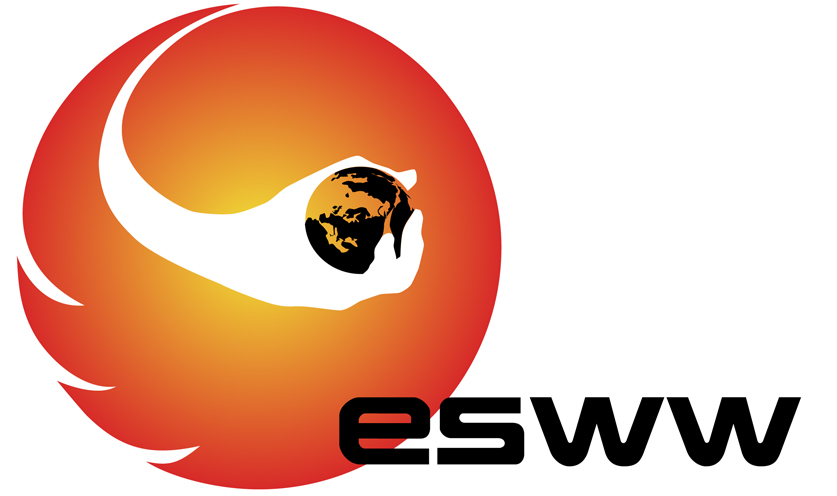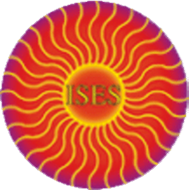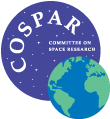
16-20 November, 2009 - Brugge, Belgium
| Session: | Poster Session 1 Space Weather and Space Situational Awareness |
| Type: | Poster session |
| Date: | 18 November 2009 |
| Time: | 16:30 - 18:30 |
| Chair: | A. Hilgers and J.-Y. Prado |
| Co-chair: | |
| Remarks: |
| Seq | Time | Title | Abs No | ||||
| 1 | 00:00 |
A Xylophone Bar Magnetometer For Micro/Pico Satellites
Lamy, Hervé1; Niyonzima, Innocent2; Rochus, Pierre3; Rochus, Véronique4 1BIRA-IASB, BELGIUM; 2University of Liège, BELGIUM; 3Centre Spatial de Liège, BELGIUM; 4University of Liège (LTAS), BELGIUM We are currently developing a miniature version of a xylophone bar magnetometer (XBM) with Micro-Electro-Mechanical Systems (MEMS). The device is based on a classical resonating xylophone bar. A sinusoidal current is supplied to the bar oscillating at the fundamental transverse resonant mode of the bar. When an external magnetic field is present, the resulting Lorentz force causes the bar to vibrate at its fundamental frequency with an amplitude directly proportional to the component of the ambient magnetic field perpendicular to the bar. We illustrate the working principles of the XBM and the challenges to reach the required sensitivity in space applications (measuring magnetic fields with an accuracy of approximately of 0.1 nT). The optimal dimensions of the MEMS XBM are discussed as well as the constraints on the current flowing through the bar. Analytical calculations as well as simulations with finite element methods have been used. A prototype has been recently built using Silicon on Insulator (SOI) and bulk micromachining processes. Several methods to accurately measure the displacement of the bar are considered. |
|||||
| 2 | 00:00 |
The New RTO Space Situational Awareness Activity
Jansen, Frank1; Cid, Consuelo2; Messerotti , Mauro3 1DLR Institute of Space Systems, GERMANY; 2Universidad de Alcala, SPAIN; 3Trieste Observatory, ITALY RTO (Research and Technology Organisation) has established in 2009 an Exploratory Team (ET) related to Space Situational Awareness. This so-called SCI-229-ET (Systems Concepts and Integration) will cover space weather, space debris and Near Earth Objects (NEOs) activities for RTO. The proposed objectives, deliverables and schedule will be sketched. |
|||||
| 3 | 00:00 |
Canadian Polar Communication and Weather Mission Perspectives
Trichtchenko, Larisa; Boteler, David Natural Resources Canada, CANADA Canadian Space Agency with the support from other Government departments is planning the operational space mission to be launched in 2016 on Highly Elliptical (Molniya) Orbit. This Polar Communication and Weather (PCW) mission aims to: Facilitate Canadian operations in the north and support Canadian sovereignty by providing reliable communications services and timely meteorological information for civilian and military operations. Improve weather forecasting, modeling and environmental monitoring by continuous observations of the Arctic, to produce high quality radiometric data that's currently unavailable or available only with insufficient spatial or temporal resolution. Improve monitoring of climate related variables to increase understanding of climate change and improve the capability to model feedback processes associated with it Contribute to the monitoring, understanding and forecasting of space weather, which refers to the continuously changing conditions in the energetic particle and electromagnetic environment in the vicinity of Earth, to reduce hazardous impacts on space-borne and ground based infrastructure, navigation and human health More details on the project will be presented in this talk. |
|||||
| 4 | 00:00 |
PROBA2: Launch of ESA's First Space Weather Mission
Berghmans, David1; Hochedez, Jean-Francois2; the SWAP and LYRA teams,2 1Royal Observatory of Belgium, BELGIUM; 2SIDC - Royal Observatory of Belgium, BELGIUM
PROBA2 is an ESA micro satellite with two space weather monitoring instruments onboard: SWAP & LYRA. SWAP is designed to image the solar corona and monitor the occurrence of all events and features that are relevant for space weather. This includes coronal holes, active regions, flares, prominences and coronal mass ejections. LYRA is a radiometer that will monitor the solar irradiance at high temporal resolution in 4 passbands that are carefully selected for their relevance in space weather, Earth aeronomy and solar physics.
At the time of this writing, PROBA2 is at the Russian launch site "Plesetsk Cosmodrome" where it is being mounted on the Eurockot launcher. Launch is foreseen for November 2, just two weeks before the ESWW6 conference. In this talk, we will thus be able to present the first news on the launch, the start of the commissioning phase and the initial performance of platform and instruments. |
|||||
| 5 | 00:00 |
Space Weather in Korea
Bae, Seok-hee; Kim, Jong-woon; Lee, Joong-il; Youn, Hun; Han, Jin-wook; Yu, Chung-hyun; Yoo, Dae-seon Radio Research Agency, KOREA, REPUBLIC OF
Radio Research Agency(RRA) is a Korean government agency which is affiliated with the Korea Communications Commission. Space weather forecast is a major function of RRA which was started from the time of its foundation in 1966. From then, RRA have been contributing to securing reliable earth-space communication environment in Korea by providing the space weather service which can affect the radio communication systems. |
|||||
| 6 | 00:00 |
ENIGMA: A New Magnetometer Array in Southeast Europe for Space Weather Monitoring
Daglis, Ioannis A.1; Balasis, Georgios1; Baumjohann, Wolfgang2; Magnes, Werner2; Mandea, Mioara3; Zesta, Eftyhia4; Saloustros, Georgios1; Georgiou, Marina1 1National Observatory of Athens, GREECE; 2Space Research Institute, Austrian Academy of Sciences, AUSTRIA; 3Helmholtz-Zentrum Potsdam, Deutsches GeoForschungsZentrum - GFZ, GERMANY; 4Space Vehicles Directorate, Air Force Research Laboratory, UNITED STATES Over the last couple of years the National Observatory of Athens (NOA) has installed and has begun operating ENIGMA (HellENIc GeoMagnetic Array), an array of 4 ground-based magnetometer stations in southeast Europe (central and southern Greece). In the near future another station will be installed in Macedonia or Thrace, and there are plans for the installation of an additional station in Crete by the end of 2009. The realization of this array has become possible through collaborations with the Space Research Institute of the Austrian Academy of Sciences and the German Research Centre for Geosciences GFZ. The existing stations are latitudinally equi-spaced between 30° and 33° corrected geomagnetic latitude. Their spatial configuration is suitable for detecting field-line resonance signatures, thus allowing the study of the dynamics of the inner magnetosphere. Field line resonance frequencies can be accurately determined by means of a cross-phase analysis of ground-based ULF wave measurements recorded at stations closely spaced in latitude. This enables monitoring of the temporal variations of the plasma mass density in the inner magnetosphere, which is a critical parameter in space weather dynamics. |
|||||
| 7 | 00:00 |
Automatic Retrieval of Plasmaspheric Electron Density
Profiles by Automatic Whistler Detector and Analyzer Network
Lichtenberger, Janos1; Ferencz, Csaba1; AWDANet Team,2 1Eotvos Univesity, HUNGARY; 2HUNGARY The cold electron density distribution of plasmasphere cannot be easily measured routinely, but is a key parameter for magnetosphere and radiation belts modeling. Whistlers have been regarded as cheap and effective tools for plasmasphere diagnostic since the early years of whistler research, but it never became a real operational tool due to the required tedious human work. Recently the Space Research Group of Eotvos University has developed a new, unique Automatic Whistler Detector and Analyzer (AWDA) system (Lichtenberger et al. 2008) that is capable to detect and process lightning whistlers with no human interaction. A network formed by AWDA systems (AWDANet) is evolving and now covers low, mid and high magnetic latitudes (Lichtenberger et al. 2008). Previously, the automatic analyzer worked only for low latitude whistler, recent developments extended the method for multiple-path whistler groups propagating on mid and high latitude (Lichtenberger, 2009). This allow us to retrieve electron density profiles automatically for wide range of L-values. The planned full setup of AWDANet will be able to provide density profiles for different MLTs which can be used as a data source in a data service for Space Weather segment in SSA. References:
Lichtenberger, J. (2009): A new whistler inversion method. Journal of Geophysical Research,114, A07222, doi: 10.1029/2008JA013799 |
|||||
| 8 | 00:00 |
Korean Space Environment Forecasting Center(KSEFC)
Park, Jae Woo1; Jeong, Cheol-O1; Bae, Seok Hee2 1ETRI, KOREA, REPUBLIC OF; 2RRA, KOREA, REPUBLIC OF Korea government decided to establish Korean space weather center to protect the ubiquitous communication infrastructure from solar radio interference, to continue the space environment including ionosphere over Korean peninsula more systematically and to play a major role through more active international cooperation. The center will be called Korean Space Environment Forecasting Center(tentative). In this talk, we introduce the build-up plan of the center more detail. Following construction of center building at Hallim, Jeju island, full scale space environment monitoring and forecasting system including forecasting and now-casting operation model, ground-based and space-based observation system will be installed. The main activities are the real-time monitoring of the solar radio, the ionosphere and geomagnetic field to minimize the radio interference on communications and the prediction services of solar radio burst, geomagnetic field variation and optimum frequency for HF communications. We have several strategies for the center in perspective. First of all it is necessary to strengthen the ground-based observation system such as installing solar radio spectrum analyzer newly, establishing ionosonde additionally and upgrading geomagnetic measurement system. Secondly the operational model should be advanced and model development infra will be equipped for transition between operation and research. For the enhancement of measurement technology the security of self-maintenance technology and participation in national or international space program for our own space environment monitoring payloads have a priority. Lastly global cooperation will be one of the most important role of our center. KSEFC will have 5 divisions and around 50 working people for full time operation and research. |
|||||
| 9 | 00:00 |
Assessing the Use of EDAM for Providing Ionospheric Corrections to UHF Space Situational Awareness Radars.
Jackson-Booth, Natasha; Angling, Matthew QinetiQ, UNITED KINGDOM Ultra high frequency radars can provide a wide area space track capability. As such, they will form a key component of ESA's space situational awareness (SSA) programme. Ionospheric effects on UHF space track radars include: refraction, incoherent scattering, phase and amplitude scintillation, and, to a lesser extent, Faraday rotation, high latitude absorption, and effects due to sporadic-E layers and travelling ionospheric disturbances (TIDs) [Coster, et al., 1993]. These effects impact upon different aspects of radar operations. For example, ionospheric refraction and unexpected gradients in the ionospheric electron density impact on the accuracy of the track position; incoherent scatter increases the noise levels and impacts on detection capability; and fading caused by scintillation impacts on the radars detection, transition to track and target discrimination capability. The TEC results in signal retardation and refraction delay, producing range and angle of arrival errors. At low elevation angles, the errors may be three times greater than those observed at the zenith due to the increased ionospheric path lengths. For this reason, UHF radars are generally equipped with an ionospheric model so that ionospheric corrections can be estimated and applied. The Electron Density Assimilative Model (EDAM) has been developed to assimilate ground and spaced based measurements of slant total electron content (TEC) into a background ionospheric model in order to produce a 3D representation of the ionospheric electron density. Such an assimilative model can be used to ensure the effective operation and planning of many radio frequency systems and could be applied to a UHF SSA radar. Data collected in September 2008 from four GPS stations located on the Kwajalein Atoll has been assimilated into EDAM. Over the same period LEO calibration spheres were tracked by the ALTAIR radar to provide high accuracy TEC measurements. These have been compared to slant TECs generated by integrating through the EDAM electron density grid. This paper will present a comparison of the measured and modelled TECs and the performance of EDAM will be compared to that of IRI (which is used as the EDAM background model). Initial results indicate marked asymmetries in how well EDAM models the TEC. Possible causes of this are under investigation and will also be presented. Acknowledgements The ALTAIR data has been kindly provided by the US Air Force Research Laboratory as part of an on-going programme of cooperation with QinetiQ and the UK MOD. References Coster, A. J., E. M. Gaposchkin, L. E. Thornton, G. R. Krumholz, and T. A. Cott (1993), Ionospheric Effects in Satellite Tracking, paper presented at Ionospheric Effects Symposium, Alexandria, VA, USA. |
|||||
| 10 | 00:00 |
New Worldwide Particle Detector Network Measuring Charged and Neutral Species of the Secondary Cosmic Rays
Chilingarian, Ashot Yerevan Physics Institute, ARMENIA
A network of detectors called SEVAN (Space Environmental Viewing and Analysis Network) is planned in the framework of the International Heliophysical Year (IHY), to improve fundamental research of the Solar accelerators and Space Weather conditions. The network will detect changing fluxes of the most of species secondary cosmic rays at different altitudes, latitudes and altitudes those constituting powerful integrated device in exploration of solar modulation effects.
Surface particle detectors measure time series of secondary particles born in cascades originated in the atmosphere by nuclear interactions of the "primary" protons and nuclei accelerated in galaxy. During violent solar explosions sometimes additional particles, accelerated at sun’s environments, are added to this "background" flux. If solar particles are energetic enough they also will generate secondary particles reaching earth surface. Therefore, registration of changing time series of secondary particles shed light on the high-energy particle acceleration mechanisms by solar flares and Coronal Mass Ejection driven shocks. |
|||||
 |
 |
 |
 |
 |
 |
 |